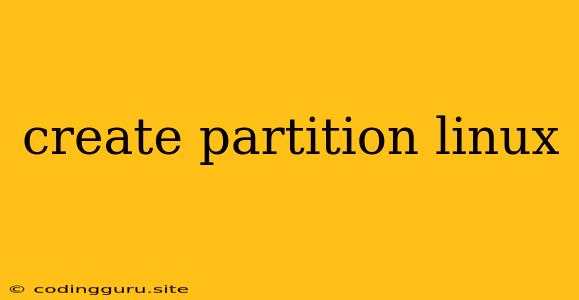Creating Partitions on Linux: A Comprehensive Guide
Linux, a powerful and versatile operating system, offers a high level of flexibility in managing your storage space. One key aspect of this control is the ability to create partitions, which allows you to organize your hard drive into distinct sections, each with its own file system and permissions. Whether you're installing a new operating system, managing multiple operating systems, or simply wanting to organize your data, understanding how to create partitions is essential.
Why Create Partitions?
Before diving into the process, let's clarify why creating partitions is beneficial:
- Organization: Dividing your hard drive into partitions helps you organize your data logically. You can dedicate separate partitions for your operating system, applications, user files, and other specific purposes.
- Multiple Operating Systems: Partitions enable you to install and run multiple operating systems on a single machine. Each operating system can reside on its own partition, keeping their files and configurations isolated.
- Data Security: Separating sensitive data like system files from user files on different partitions provides an additional layer of security. If one partition becomes corrupted, it's less likely to affect others.
- Performance: By allocating specific partitions for specific tasks (e.g., a dedicated partition for swap space), you can optimize system performance.
- Backup and Recovery: Partitions simplify the process of backing up and restoring data. You can easily back up specific partitions or even create full disk images for disaster recovery.
Understanding Partition Types
There are two main types of partitions:
- Primary Partitions: These are the primary partitions on your hard drive, and you can have a maximum of four primary partitions.
- Logical Partitions: Created within an extended partition, these partitions offer more flexibility and allow you to have more than four partitions on your hard drive.
The Tools of the Trade
Several tools are commonly used for creating partitions on Linux:
- fdisk: This command-line utility is a powerful and flexible option for managing partitions. It offers fine-grained control over partition creation, formatting, and resizing.
- parted: Another command-line tool that provides a user-friendly interface for managing partitions. It's particularly useful for managing large hard drives and supports advanced features like resizing partitions without data loss.
- GParted: A graphical partitioning tool that simplifies the process of creating partitions for users who prefer a visual interface. It's available in many Linux distributions and offers a straightforward way to manage partitions.
Creating Partitions Using fdisk
Here's a step-by-step guide to creating partitions using fdisk:
-
Identify Your Hard Drive: Run the command
lsblkto list all available block devices. Identify the drive you want to partition. -
Start fdisk: Use the command
sudo fdisk /dev/sdX(where X is the identifier of your hard drive). This will launch fdisk in interactive mode. -
Create a New Partition: Enter the command
nto create a new partition.- Choose the partition type (p for primary or e for extended).
- Specify the partition number.
- Set the first sector and last sector of the partition (fdisk will guide you through this).
-
Format the Partition: After creating the partition, you need to format it using a file system. Use the command
mkfs.ext4 /dev/sdX1(replaceext4with your desired file system and1with the partition number) to format the partition. -
Mount the Partition: Once formatted, you can mount the partition to access it. Use the command
sudo mount /dev/sdX1 /mnt/mypartitionto mount the partition to the directory/mnt/mypartition.
Creating Partitions Using Parted
Here's how to create partitions with parted:
-
Open parted: Run the command
sudo parted /dev/sdX(where X is the drive you want to partition). -
Print the Partition Table: Enter the command
printto display the current partition table. -
Create a New Partition: Use the command
mklabel gptto create a GUID Partition Table (GPT). Then, use the commandmkpart primary ext4 0% 50%to create a primary partition named "ext4" that occupies the first 50% of the disk. -
Format the Partition: Use the command
mkfs.ext4 /dev/sdX1to format the partition with the ext4 file system. -
Mount the Partition: As before, you can mount the partition using
sudo mount /dev/sdX1 /mnt/mypartition.
Creating Partitions Using GParted
GParted provides a visual and intuitive interface for managing partitions.
- Open GParted: Start GParted from your Linux distribution's menu.
- Select Your Disk: Choose the hard drive you want to partition.
- Create a New Partition: Click the "New" button and follow the prompts. Select the file system, size, and location of the partition.
- Apply Changes: Review your changes and click "Apply" to save the changes to your disk.
Important Tips
- Backup Your Data: Before making any changes to your hard drive partitions, always back up your important data to prevent accidental loss.
- Understanding Partition Tables: There are two common partition table schemes: Master Boot Record (MBR) and GUID Partition Table (GPT). GPT offers more flexibility and supports larger hard drives, while MBR is the older standard. Choose the appropriate scheme for your needs.
- Choose the Right File System: Select a file system that's compatible with your operating system and application needs. Common Linux file systems include ext2, ext3, ext4, XFS, and Btrfs.
- Be Cautious With Resizing: Resizing partitions can be risky, especially if you have data on the partition. Use specialized tools like GParted for safe resizing.
Conclusion
Creating partitions on Linux is a powerful technique for organizing your storage, managing multiple operating systems, and enhancing data security. By understanding the different tools, types of partitions, and file systems, you can effectively manage your hard drive and make the most of your Linux experience. Remember to back up your data before making any changes and proceed with caution.
